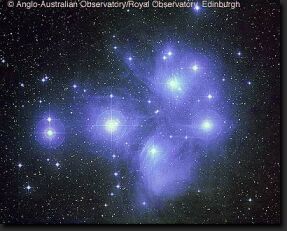B stars within 100 light-years

B stars within 100 light-years |

|
|
| Home | Stars | Habitability | Life | |
 © 2005 Sol Company
© 2005 Sol Company
Larger map.
Blue-white "B" stars
are among the
brightest stars in
Earth's night sky.
Summary
Only four stars of spectral type "B" (not including white dwarf stellar remnants) are currently believed to be located within 100 light-years or (or 30.7 parsecs) of Sol. All named, they are Algol, Algorab, Alperatz, and Regulus Aa. These relatively bright, large, massive, and rare stars are visually prominent objects in Earth's night sky.
 ©
AAO/ROE, photo by
David
Malin
©
AAO/ROE, photo by
David
Malin
(Used with permission)
Larger labelled image of Pleiades.
Algol A is a blue-white star
that is larger, brighter, and
hotter than Sirius A, like six
of the brightest stars of the
Pleiades
Cluster at left.
Stars of spectral type B are very hot, bright, and bluish, emitting a high proportion of their radiation in ultraviolet wavelengths from stellar surfaces of around 9,750 to 31,000° K. B stars have spectra that are characterized by absorption lines of neutral helium which reach their maximum intensity at B2, and strong Balmer lines of hydrogen and lines of singly ionized oxygen and other gases. These hot stars range in mass from around three to 20 Solar-masses, which indicates that B stars are very short-lived and may spend from 400 to as few as 10 million years in the main sequence fusing core hydrogen.

NASA
Observatorium
As a B star,
Spica
is hotter,
brighter, and
bluer than A
stars such as
Vega
or
Sirius A.
See a discussion of
the
"main
sequence"
as part of
stellar
evolution and death.
B stars are frequently found near (and may even be gravitationally bound) to even higher mass, spectral type "O" stars in or near stellar nurseries as OB associations. Usually found in the galactic plane where there are dusty clouds of gas, B stars are very rare (comprising around only 0.1 percent of dwarf stars). However, B stars have visual luminosities of around 100 to 40,000 times that of Sol for B supergiants like Rigel, and so these stars are abundantly visible in Earth's night sky despite their far distances.
 S. Van Dyk, IPAC (2MASS Atlas Image
Gallery)
S. Van Dyk, IPAC (2MASS Atlas Image
Gallery)
Herbig Be star, R
Coronae Australis -- larger
image.
(See a Digitized Sky Survey
image
of R CrA from
NASA's
NStars Database.)
Atlas Image mosaic obtained as part of the Two Micron All Sky Survey
(2MASS), a joint project of the University of Massachusetts and the
Infrared Processing and Analysis Center/California Institute of
Technology, funded by the National Aeronautics and Space Administration
and the National Science Foundation.
"Be" stars (such as R Coronae Australis) display at least one of the hydrogen Balmer lines. These stars rotate rapidly within a circumstellar shell and/or disk of gas that may have been thrown off by the star or accreted from an evolved companion star. Such stars vary in both brightness and spectra. (More information and a list of these stars are available from astronomer Perry Berlind's page on B stars.)
Nearby B Stars by Distance
The following celestial objects are located within 31 parsecs, 100 light-years (ly), of Sol.
Other Information
Summary information on bluish white A, yellowish F, yellow-orange G, orange-red K, and many red M stars within 100 light-years are also available.
Try Professor James Kaler's Stars site for more discussion of spectral classification as well as information on individual blue-white stars. See also Chris Clowe's summary of spectral type B stars.
Up-to-date technical summaries on some stars can be found at: NASA Star and Exoplanet Database, the Astronomiches Rechen-Institut at Heidelberg's ARCNS, Centre de Données astronomiques de Strasbourg's SIMBAD, and www.alcyone.de's bright star catalogue search. Additional information may be available at Roger Wilcox's Internet Stellar Database.
For more information about stars including spectral and luminosity class codes, go to ChView's webpage on The Stars of the Milky Way.
© 2005-2010 Sol Company. All Rights Reserved. |